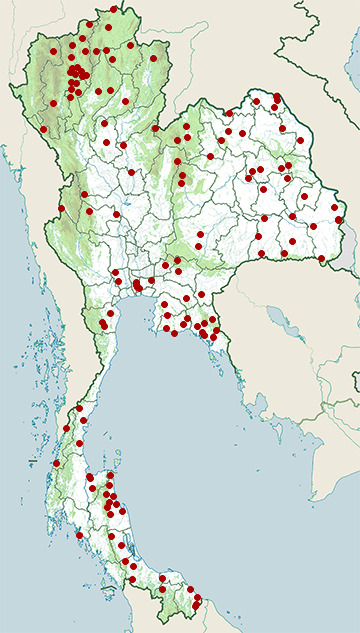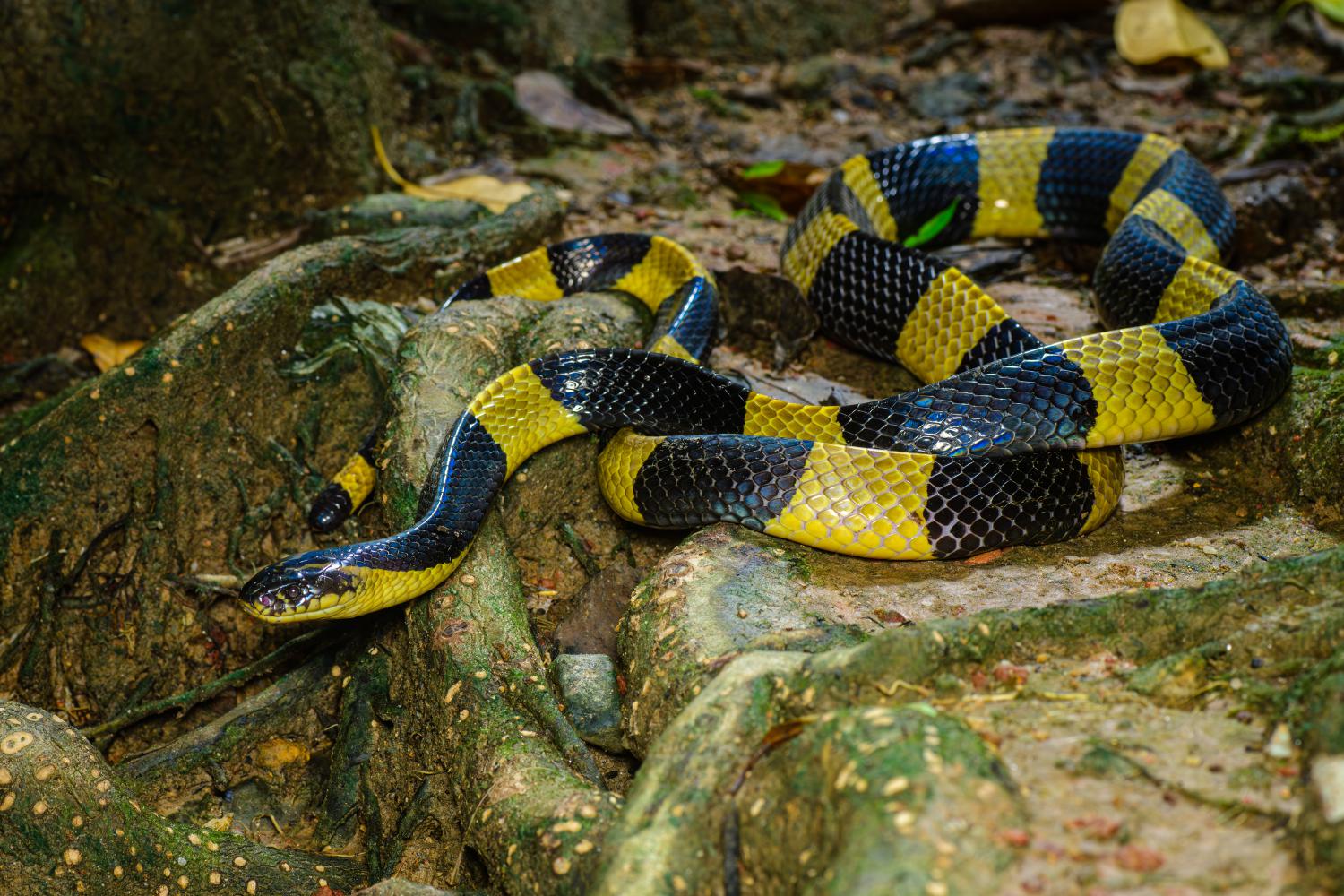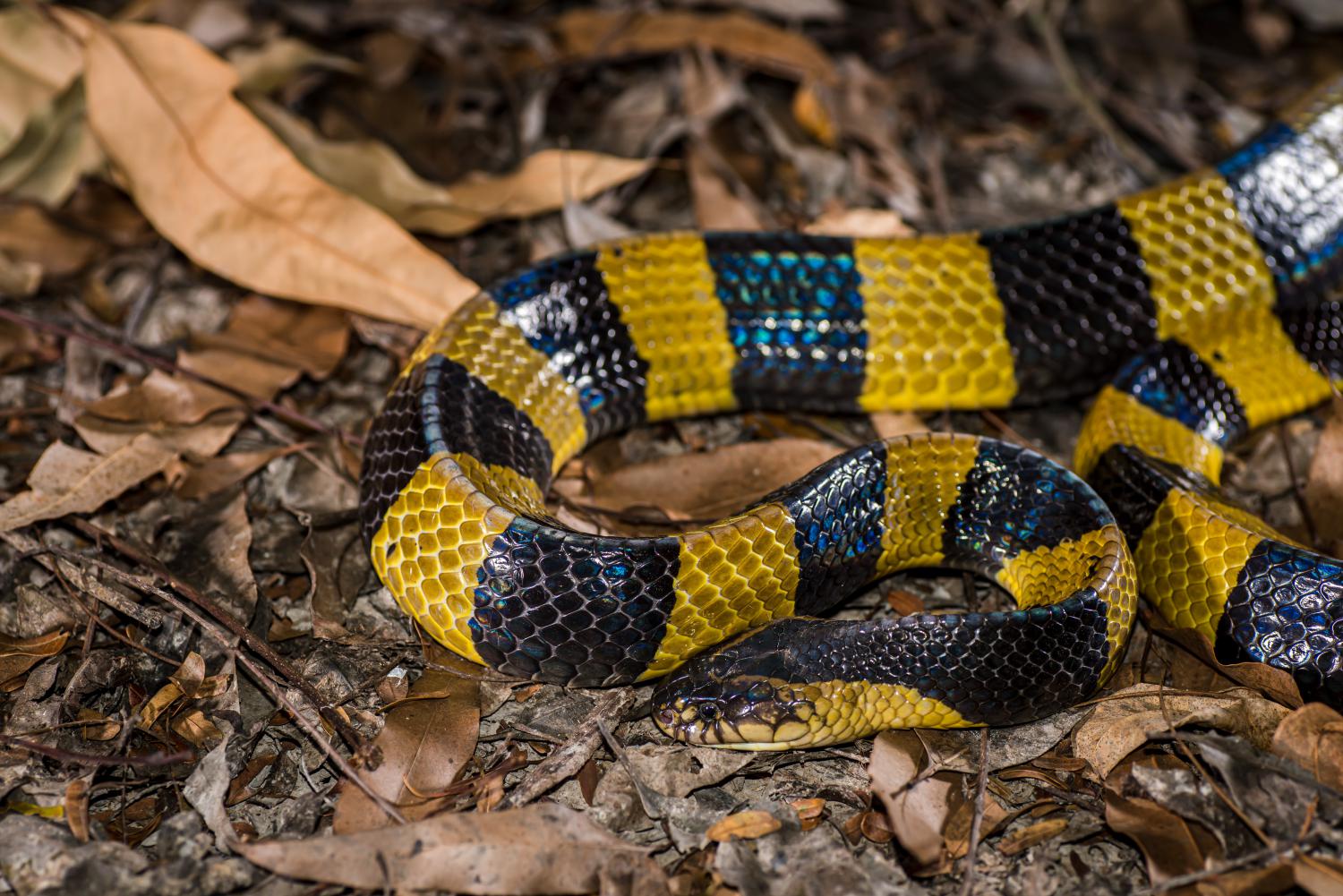Species of Thailand
Banded krait
Bungarus fasciatus
(Johann Gottlob Theaenus Schneider, 1801)
In Thai: งูสามเหลี่ยม, ngu saam liam
The banded krait (Bungarus fasciatus) is a species of elapids endemic to Asia, from Indian Subcontinent through Southeast Asia to Southern China. With a maximum length exceeding 2 m, it is the longest krait with a distinguishable gold and black pattern. While this species is generally considered timid and docile, resembling other members of the genus, its venom is highly neurotoxic which is potentially lethal to humans. Although toxicity of the banded krait based upon murine experiments is lower than that of many other kraits, its venom yield is the highest due to its size.
Description
The banded krait is easily identified by its alternate black and yellow crossbands all of which encircle the body. The head is broad and depressed and it is not distinct from the neck. The eyes are black. It has arrowhead-like yellow markings on its otherwise black head and has yellow lips, lores, chin, and throat. The tail is relatively small, about one-tenth the length of the snake.
The longest banded krait measured was 2.25 m long, but normally the length encountered is 1.8 m.
Scalation: 15 dorsal scale rows at midbody; sub-caudal scutes undivided throughout, 23–39; middorsal row of scales (vertebrals) hexagonal & strongly enlarged, as broad as or broader than long; anal plate undivided. tail end blunt; distinct vertebral ridge down the back formed by the neural processes of the vertebrae; ventrals 200–234.
Bungarum Pamah was the name recorded by Patrick Russell of a specimen from "Mansoor Cottah", he also received specimens from Bengal. The scientific name of the genus is derived from 'bangarum' in Telugu (also in Kannada), meaning "gold", referring to the yellow rings around its body.
Distribution and habitat
The banded krait occurs in the whole of the Indo-Chinese subregion, the Malay Peninsula and Indonesian archipelago, and southern China. The species is common in the states of West Bengal, Odisha, Mizoram, Assam, Manipur and Tripura of India, Nepal and Bangladesh, but becomes progressively uncommon westwards in India.
It has been recorded eastwards from central India through Nepal, Bangladesh, Myanmar, Cambodia, Thailand, Laos, Vietnam, and southern China (including Hainan and Hong Kong), Malaysia and the main Indonesian islands of Borneo (Java and Sumatra), as well as Singapore.
In India, it has been recorded from Andhra Pradesh, Bihar, Chhattisgarh, Jharkhand, Madhya Pradesh, Maharashtra, Northeast India, Odisha, Tamil Nadu, and West Bengal. It has recently been recorded from Hassan District in Karnataka, Chalkari, Bokaro District, Jharkhand, Trivandrum, Kerala and Amalapadu, Srikakulam District, Andhra Pradesh
Banded kraits may be seen in a variety of habitats, ranging from forests to agricultural lands. They inhabit termite mounds and rodent holes close to water, and often live near human settlement, especially villages, because of their supply of rodents and water. They prefer the open plains of the countryside. The banded krait has been found in Myanmar up to an altitude of 5000 feet.
Behaviour
Banded kraits are shy, not typically seen, and are mainly nocturnal. When harassed, they will usually hide their heads under their coils, and do not generally attempt to bite, though at night they are much more active and widely considered to be more dangerous then.
During the day, they lie up in grass, pits, or drains. The snakes are lethargic and sluggish even under provocation. They are most commonly seen in the rains.
Food
The banded krait feeds mainly on other snakes, but is also known to eat fish, frogs, skinks, and snake eggs. Among the snakes taken by banded kraits are:
- Sunbeam snake Xenopeltis unicolor
- Rainbow water snake Enhydris enhydris
- Red-tailed pipe snake Cylindrophis ruffus
- Chequered keelback Fowlea piscator
- Buff-striped keelback Amphiesma stolatum
- Rat snake or dhaman Ptyas mucosus
- Indo-Chinese rat snake Ptyas korros
- Cat snake Boiga trigonata.
- Russell's viper (Daboia russelii)
- Common krait (Bungarus caeruleus)
The prey is swallowed head first, after it has been rendered inactive by the venom.
Breeding habits
Little is known of its breeding habits. In Myanmar, a female has been dug out while incubating a clutch of eight eggs, four of which hatched in May. Young have been recorded to measure 298 to 311 mm on hatching. The snake is believed to become adult in the third year of its life, at an approximate length of 914 mm.
Venom
The venom of the banded krait mainly contains neurotoxins (pre- and postsynaptic neurotoxins) with values of 2.4 mg/kg–3.6 mg/kg SC, 1.289 mg/kg IV and 1.55 mg/kg IP. The quantity of venom delivered averages out at 20–114 mg. Engelmann and Obst (1981) list the venom yield at 114 mg (dry weight). The major clinical effects caused by the venom of this species include vomiting, abdominal pain, diarrhoea, and dizziness. Severe envenomation can lead to respiratory failure and death may occur due to suffocation. Banded krait venom can damage the kidneys if injected.
A clinical toxicology study gives an untreated mortality rate of 1–10%, which may be because contact with humans is rare and when bites do occur, the rate of envenomation when biting defensively is thought to be very low. Currently, polyvalent antivenoms are available in India and Indonesia.
Common names
- Manipuri language –
- Mizo language – ,
- Kannada – (ಕಟ್ಟಿಗೆ ಹಾವು)
- Karbi language – ,
- Assamese language – (শখা), (শংখচোৰ), (গোৱালা),
- Bengali – (শঙ্খিনী), (শাঁখামুঠি) and (king snake) in Birbhum District কুসাপা (রাজবংশি ভাষায়)
- Burmese – ငန်းတော်ကျား
- Hindi –
- Indonesian –
- Malayalam – (മഞ്ഞവരയൻ)
- Marathi – , पट्टेरी मण्यार ,
- Odia – (ରଣା)
- Tamil – (கட்டுவிரியன்), yennai viriyan, yettadi viriyan
- Telugu – (కట్ల పాము) or bangaru paamu (బంగారు పాము) meaning the golden snake
- Tulu –
- Thai – , งูสามเหลี่ยม, meaning the triangular snake
- Vietnamese –
- Nepali – नेपाली – गनगलि, गनग्वली, राजा साप वा सर्प , and (king of snakes) in Nepal
- Maithili – मैथिली – गन गुआर
This article uses material from Wikipedia released under the Creative Commons Attribution-Share-Alike Licence 3.0. Eventual photos shown in this page may or may not be from Wikipedia, please see the license details for photos in photo by-lines.
Scientific classification
- Kingdom
- Animalia
- Phylum
- Chordata
- Subphylum
- Vertebrata
- Class
- Reptilia
- Order
- Squamata
- Suborder
- Serpentes
- Family
- Elapidae
- Genus
- Bungarus
- Species
- Bungarus fasciatus
Common names
- German: Gelbgebänderter Krait
- English: Banded krait
- Thai:
- งูสามเหลี่ยม, ngu saam liam
- งูปล้องทอง (ใต้), ngu plong thong (South Thailand)
Conservation status

Least Concern (IUCN3.1)
Photos
Please help us review our species pages if wrong photos are used or any other details in the page is wrong. We can be reached via our contact us page.
Range Map

- Ban Bueng District, Chonburi
- Ban Hong District, Lamphun
- Ban Lat District, Phetchaburi
- Ban Na San District, Surat Thani
- Bang Kruai District, Nonthaburi
- Bangkok Noi District, Bangkok
- Bangkok Yai District, Bangkok
- Bo Rai District, Trat
- Bung Khla District, Bueng Kan
- Chai Prakan District, Chiang Mai
- Chiang Dao District, Chiang Mai
- Chiang Kham District, Phayao
- Doi Saket District, Chiang Mai
- Doi Suthep - Pui National Park
- Hat Yai District, Songkhla
- Hot District, Chiang Mai
- Huai Kha Khaeng Wildlife Sanctuary
- Kaeng Krachan District, Phetchaburi
- Kaeng Tana National Park
- Kantharawichai District, Maha Sarakham
- Kap Choeng District, Surin
- Khanom District, Nakhon Si Thammarat
- Khao Chaison District, Phatthalung
- Khao Chamao - Khao Wong National Park
- Khao Khitchakut National Park
- Khao Laem Ya - Mu Ko Samet National Park
- Khao Saming District, Trat
- Khao Tha Petch Wildlife Conservation and Developme
- Khao Yai National Park
- Khlong Nakha Wildlife Sanctuary
- Kho Wang District, Yasothon
- Khok Pho District, Pattani
- Khong Chiam District, Ubon Ratchathani
- Kra Buri District, Ranong
- Kuchinarai District, Kalasin
- Lan Saka District, Nakhon Si Thammarat
- Lang Suan District, Chumphon
- Mae Ai District, Chiang Mai
- Mae Chai District, Phayao
- Mae Mo District, Lampang
- Mae On District, Chiang Mai
- Mae Rim District, Chiang Mai
- Mae Sai District, Chiang Rai
- Mae Taeng District, Chiang Mai
- Mae Tha, Lamphun District, Lamphun
- Mae Wong National Park
- Mueang Amnat Charoen District, Amnat Charoen
- Mueang Chanthaburi District, Chanthaburi
- Mueang Chiang Mai District, Chiang Mai
- Mueang Chiang Rai District, Chiang Rai
- Mueang Chumphon District, Chumphon
- Mueang Kalasin District, Kalasin
- Mueang Lampang District, Lampang
- Mueang Lamphun District, Lamphun
- Mueang Loei District, Loei
- Mueang Nakhon Nayok District, Nakhon Nayok
- Mueang Nakhon Pathom District, Nakhon Pathom
- Mueang Nakhon Ratchasima District, Nakhon Ratchasima
- Mueang Nakhon Si Thammarat District, Nakhon Si Thammarat
- Mueang Narathiwat District, Narathiwat
- Mueang Nong Khai District, Nong Khai
- Mueang Phayao District, Phayao
- Mueang Phichit District, Phichit
- Mueang Phrae District, Phrae
- Mueang Rayong District, Rayong
- Mueang Roi Et District, Roi Et
- Mueang Surat Thani District, Surat Thani
- Mueang Surin District, Surin
- Mueang Udon Thani District, Udon Thani
- Mueang Uthai Thani District, Uthai Thani
- Na Wa District, Nakhon Phanom
- Nam Nao National Park
- Namtok Phlio National Park
- Nong Bua Daeng District, Chaiyaphum
- Nong Chok District, Bangkok
- Nong Han District, Udon Thani
- Nong Na Kham District, Khon Kaen
- Nong Phok District, Roi Et
- Nong Wua So District, Udon Thani
- Nopphitam District, Nakhon Si Thammarat
- Pa Sang District, Lamphun
- Pai District, Mae Hong Son
- Pak Phanang District, Nakhon Si Thammarat
- Pak Thong Chai District, Nakhon Ratchasima
- Phrai Bueng District, Sisaket
- Phrao District, Chiang Mai
- Phrom Khiri District, Nakhon Si Thammarat
- Phrom Phiram District, Phitsanulok
- Phu Khiao Wildlife Sanctuary
- Phu Luang Wildlife Sanctuary
- Phu Si Than Wildlife Sanctuary
- Phu Sing District, Sisaket
- Phu Suan Sai National Park
- Phu Wua Wildlife Sanctuary
- Pla Pak District, Nakhon Phanom
- Pluak Daeng District, Rayong
- Pong Nam Ron District, Chanthaburi
- Prachantakham District, Prachinburi
- Pua District, Nan
- Rat Burana District, Bangkok
- Rattaphum District, Songkhla
- Ron Phibun District, Nakhon Si Thammarat
- Sadao District, Songkhla
- San Kamphaeng District, Chiang Mai
- San Pa Tong District, Chiang Mai
- San Sai District, Chiang Mai
- Seka District, Bueng Kan
- Si Banphot District, Phatthalung
- Si Mueang Mai District, Ubon Ratchathani
- Si Samrong District, Sukhothai
- Si Satchanalai District, Sukhothai
- Sichon District, Nakhon Si Thammarat
- Sirindhorn Peat Swamp Forest
- So Phisai District, Bueng Kan
- Su-ngai Kolok District, Narathiwat
- Tak Bai District, Narathiwat
- Tha Mai District, Chanthaburi
- Tha Sae District, Chumphon
- Tha Sala District, Nakhon Si Thammarat
- Tha Song Yang District, Tak
- Tha Takiap District, Chachoengsao
- Tha Tum District, Surin
- Tha Yang District, Phetchaburi
- Thung Yai Naresuan Wildlife Sanctuary
- Wang Nam Yen District, Sa Kaeo
- Wang Saphung District, Loei
- Warin Chamrap District, Ubon Ratchathani
- Wiang Pa Pao District, Chiang Rai
- Yaha District, Yala
- Yang Talat District, Kalasin
- Yod Dom Wildlife Sanctuary




